Travel & Outdoors
The Canton Kayak Club Wants Baltimoreans on the Water
Despite the city's reputation as being built by and for ship-builders, dockworkers, and fishermen, many of its current residents don’t get out on the water. For 25 years, the club has been working to change that.
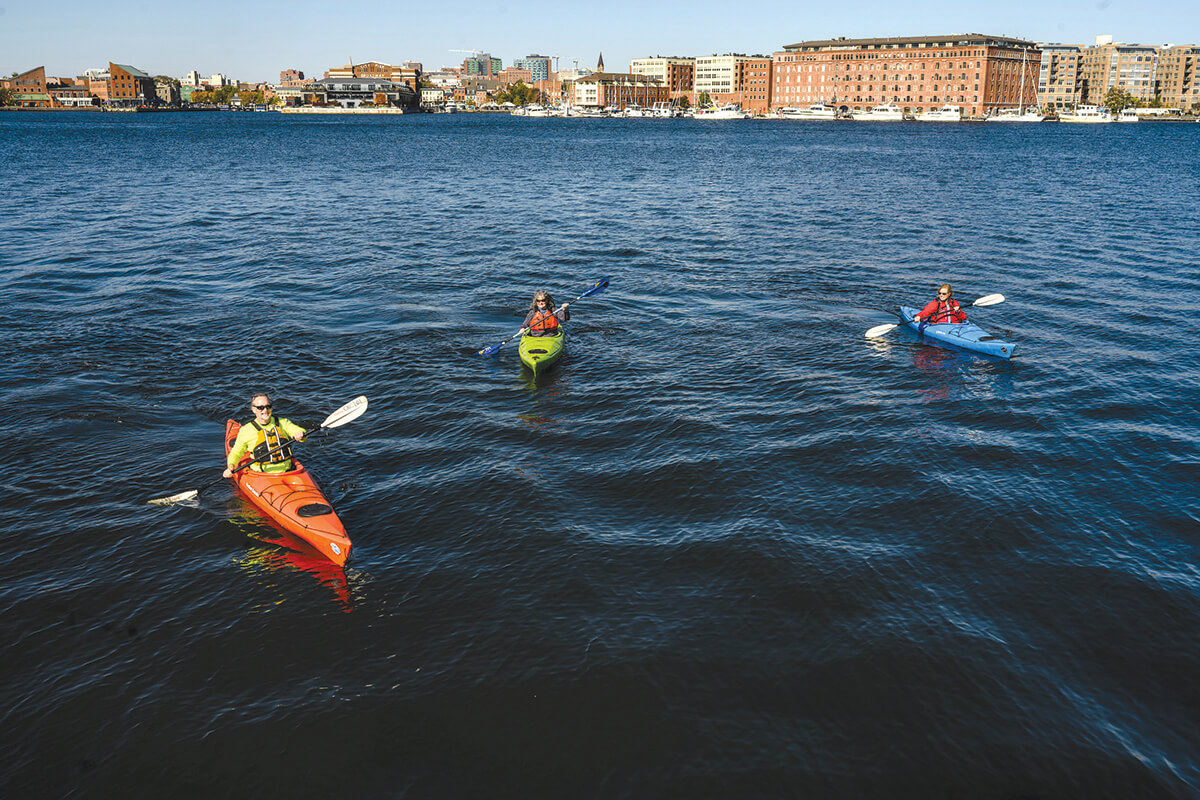
One morning just after dawn early last November, a small group of kayakers gathered at the Tide Point dock, outside the Under Armor headquarters on Locust Point, with hats pulled down and coffee in hand to ward off the chill. Rob Bennett unlocked the metal box that held the Canton Kayak Club’s life jackets, then did the same for the cables that wound around the club’s kayaks, stacked on racks in brightly colored, jigsaw fashion. The kayakers lowered the boats into the water, then lowered themselves into the shallow cockpits, grabbed their paddles and pushed off into the harbor.
Soon Bennett, a communications professor who lives in Federal Hill and kayaks about four times a week, was leading the way, paddling out into the water as squadrons of geese networked the sky and the morning sunlight sent rivers of gold and silver across the Inner Harbor. They paddled past a massive cargo ship, the Ravenna, docked at the Domino Sugar Refinery, past the Rusty Scupper restaurant and the adjacent marina, skirted the aquarium and the World War II-era Torsk submarine, then worked their way back across the harbor.
The city rose around them, an old port town seen from maybe its best vantage: from the water.
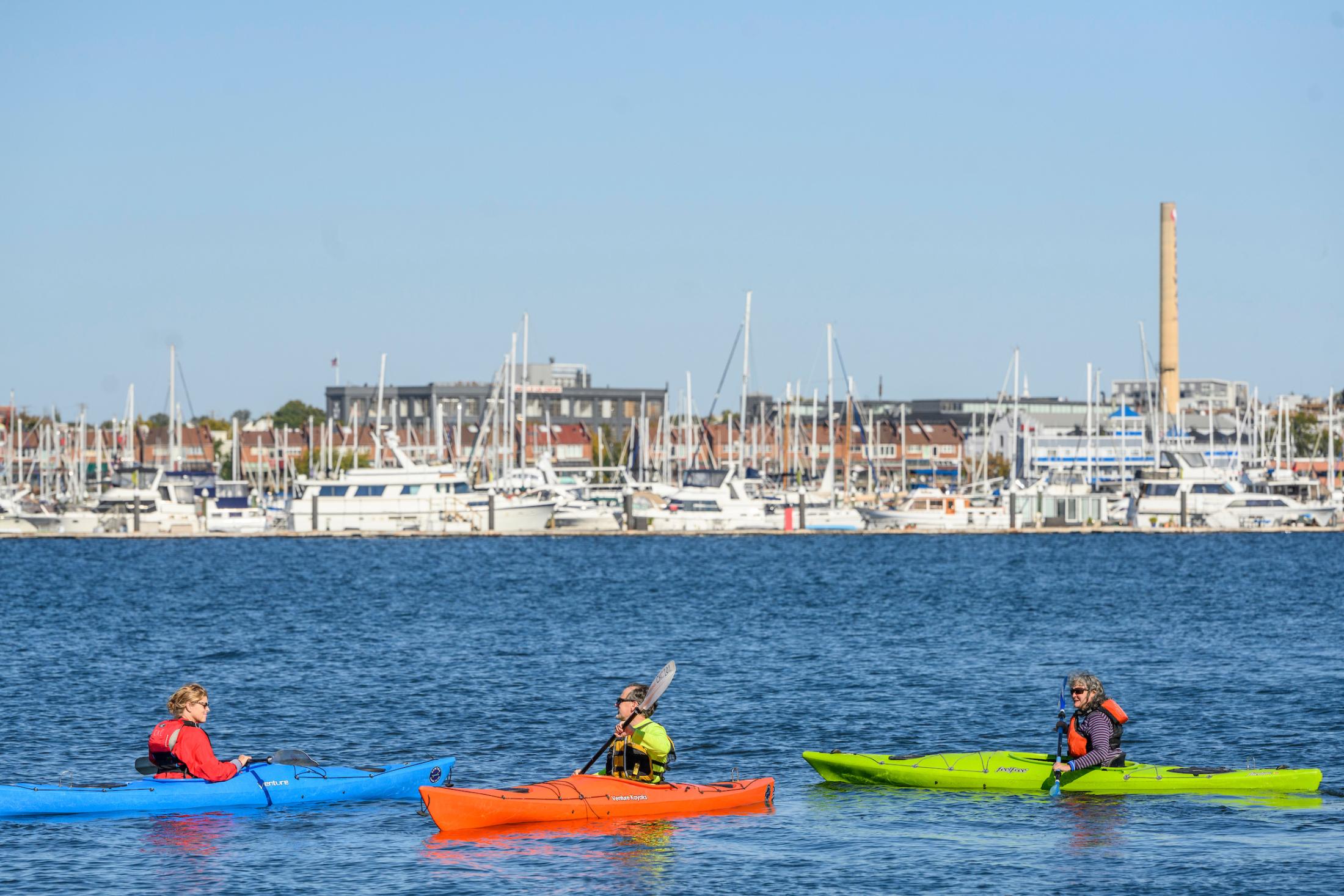
The Canton Kayak Club was launched, both figuratively and literally, almost 25 years ago, in 1999. Friends and fellow recreational kayakers Charlie Gjerde and Bill Struever came up with the idea of doing their harbor commute on the water rather than around it.
“Bill was on one side of the harbor and I was on the other,” says Gjerde, a local restaurateur who grew up kayaking on Deep Creek Lake with his brother Spike, also a restaurateur. So the pair bought some kayaks and put in a few docking stations—in Canton, Tide Point, and Fells—and started to spread the word. “It was just a good idea,” Gjerde says. “It was super cheap; you had access. We just made it up as we went along.”
Gjerde and Struever, a real estate developer known for his remaking of Baltimore’s industrial port, built up a membership base, turned the club into a nonprofit, and implemented a training program, with Gjerde doing the training, though first he had to figure out how to do it.
“I’m a restaurant guy,” he says, “I literally was looking up ‘kayak training’ on YouTube.” Gjerde loved being on the water in the middle of the city. “Being on a little kayak right on the water, cruising around these huge ships,” he says. “I thought that was the coolest part.”
Two years later, when NPR did a story about the club—Gjerde took longtime NPR host Brian Naylor out on the water, the splash of oars forming the soundtrack of the piece—there were about 70 members. At the end of the 2022 season, which runs from May to late October or early November, the number had grown to 700. That 700 includes people of all demographics, whose ages run the gamut from just-turned-18 to over 90.
“IT WAS JUST A GOOD IDEA. IT WAS SUPER CHEAP…WE JUST MADE IT UP AS WE WENT ALONG.”
Not much has changed in the quarter century since the club began, though more members mean there are more kayaks and more docks. The basic premise is the same: a community of recreational kayakers who, for a small annual membership fee ($165 for new members, $135 for returning members), get access to boats, gear, and training, and to the water itself. Though the club may have started as way to commute, these days it’s used by recreational kayakers who go out singly or in groups of varying sizes.
“We fit between the [boat] rental companies and individual kayak ownership,” says Ray Scurr, an auditor for T. Rowe Price who joined the club 10 years ago and has been its president for the last six. “For many people, particularly city-dwellers who don’t have space to store a kayak, it makes perfect sense,” says Scurr.
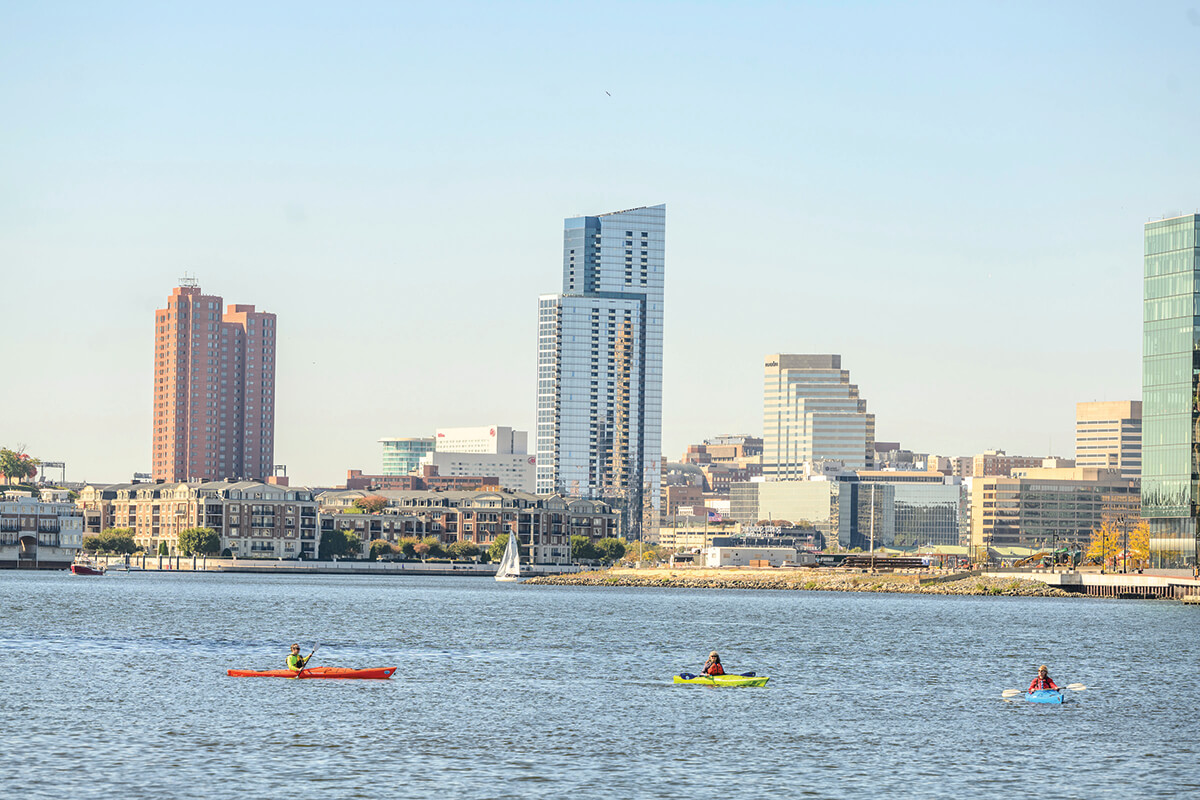
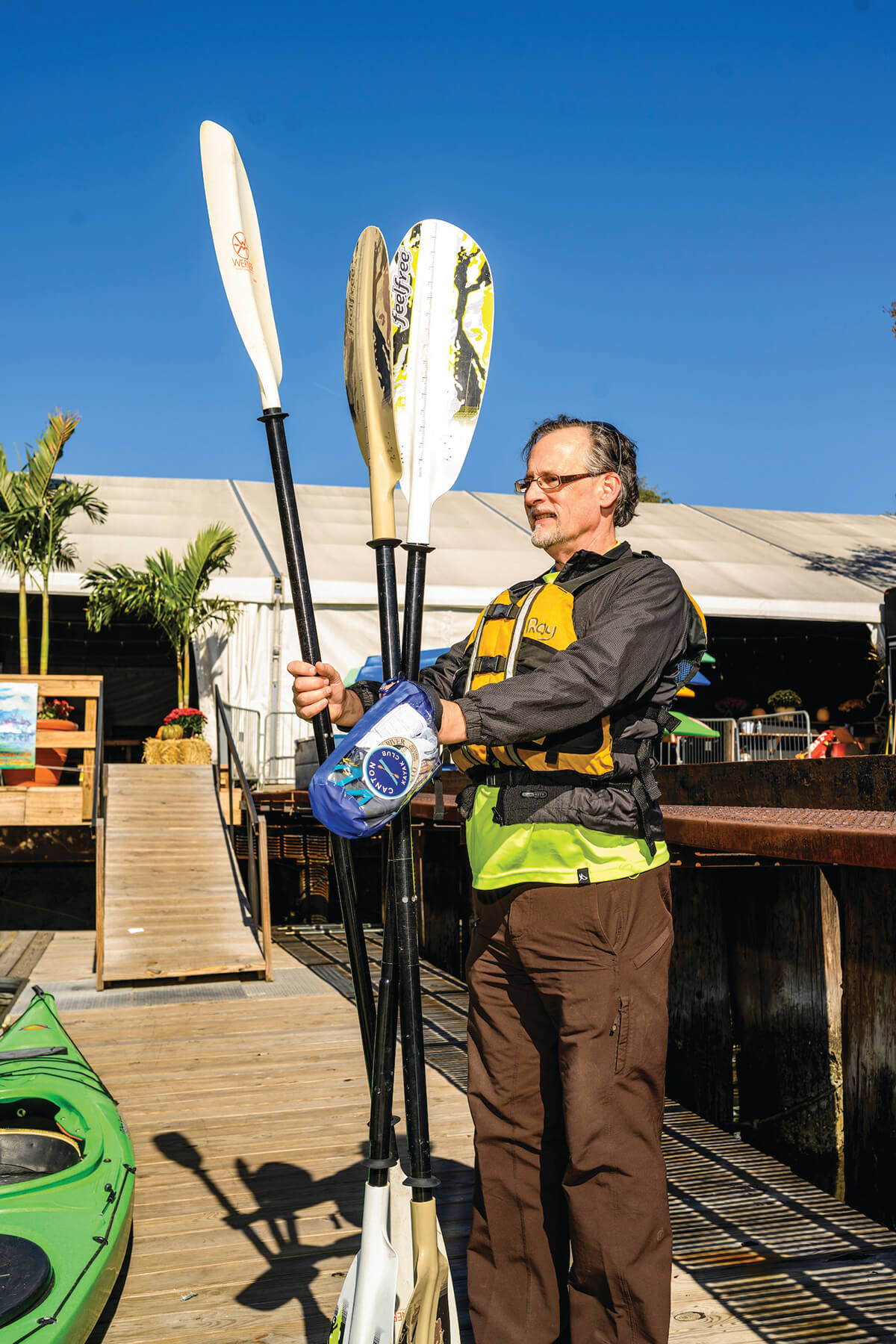
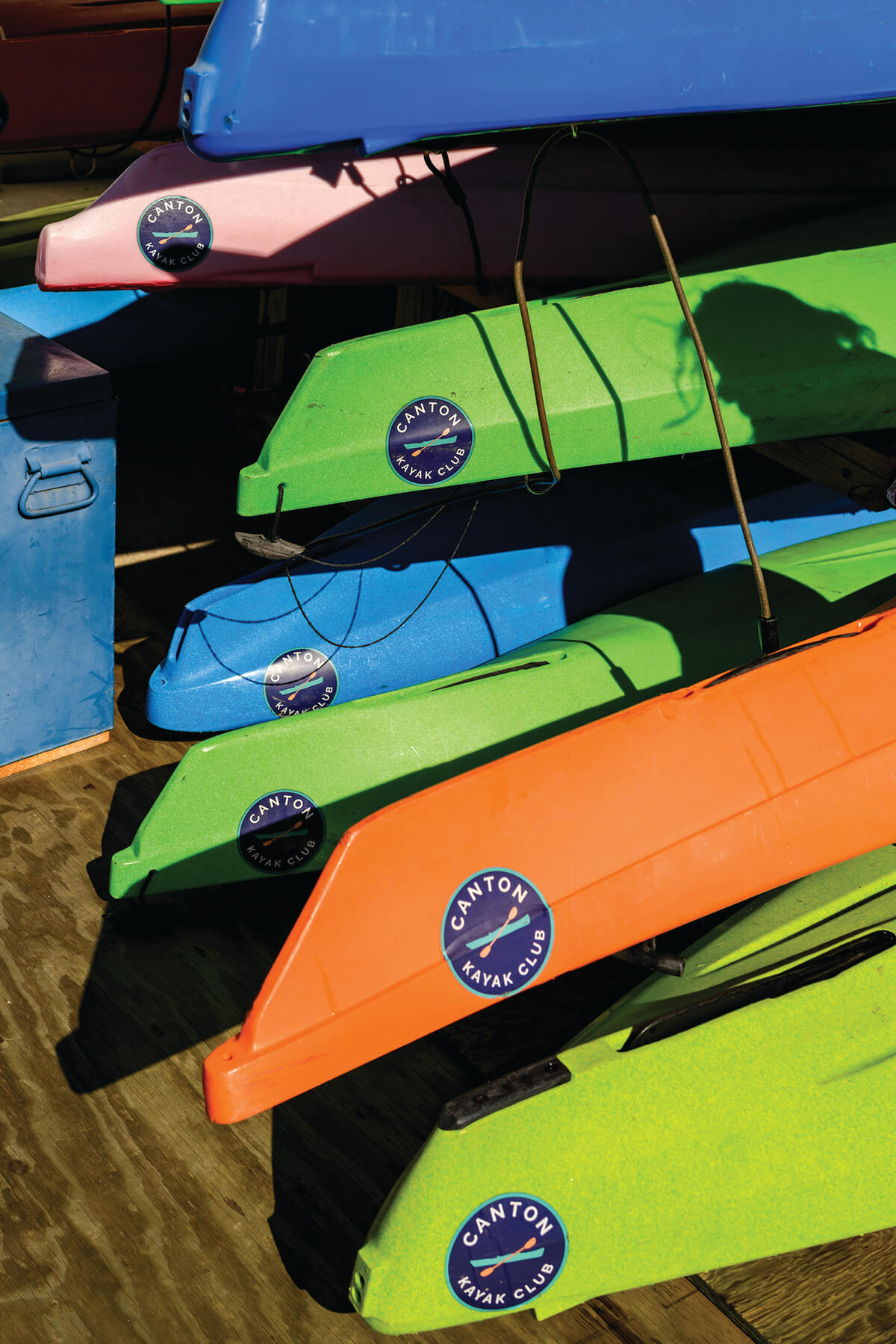
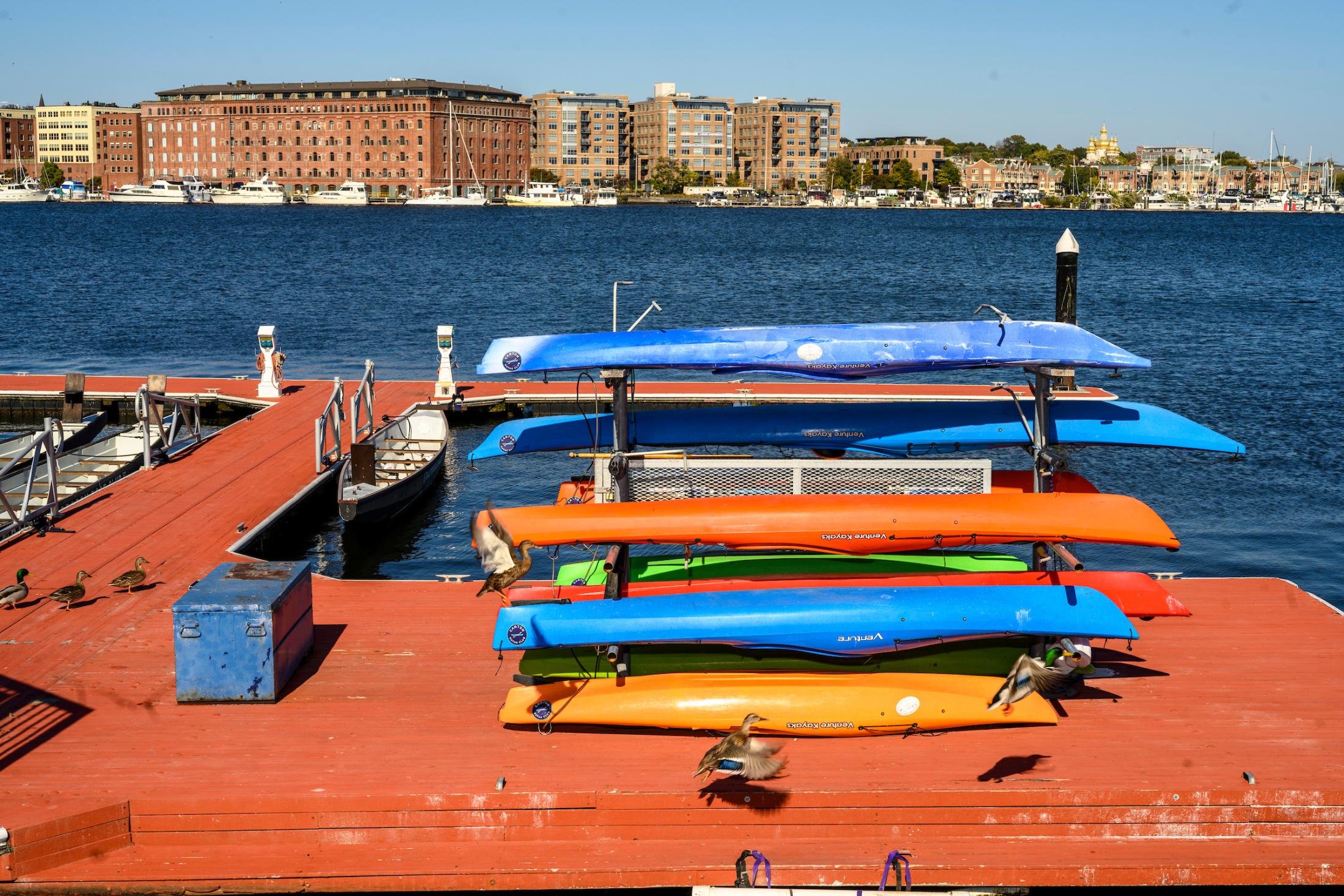
The club remains entirely run by volunteers. Overall, the club has a very small footprint, with no offices or clubhouse, only a series of kayak racks set up on various docks. The Canton dock for which the club was named closed years ago, but the original docks on Fells Point and Locust Point are still in place, as well as newer docks in Dundalk, Essex Island, Pasadena, Chesapeake Harbour in Annapolis, and Delta, PA.
If you drive an hour north of Baltimore, down a winding, tree-lined road that eventually dead-ends at the Susquehanna River, two racks of kayaks sit on the edge of a parking lot fronting the water. You’re in Delta—the farthest afield of the Canton Kayak Club’s half-dozen docks—a few miles over the Pennsylvania state line, and a few hundred yards from Starrk Moon Kayaks, which Brad Nelson has owned for over 35 years.
Nelson’s kayak shop is built into his home, itself a hodgepodge wood cabin decorated with art, patio umbrellas, weather vanes, and, in his adjacent shop and outside, kayaks—he has about 180 in total—lined up around the house like spokes on a massive wheel. A trailer across the road houses the paddles and life jackets that the club uses, and is buttressed by more kayaks. Nelson has been involved with the Canton Kayak Club for most of its history, selling it boats as well as providing upkeep on the small fleet. Nelson has also been a member for years, and kayaked himself until a non-kayaking accident a few years ago took one of his legs. He now provides all the club’s 120 or so kayaks, mostly 14-to-17-foot Venture and P&H sea kayaks, made in England, including a few tandem boats.
Despite, or maybe because of, his remote location, Nelson does quite a lot of business selling kayaks to recreational enthusiasts as well as white-water boaters, catering to people who come from West Virginia, northern Virginia, and D.C., where white-water kayaking is particularly popular. Maybe it’s because Nelson is an engaging guy, or because his shop is in such a remote location, but people tend to talk to him. “I get stories here that I shouldn’t even be hearing,” he says with a laugh, “on a dead-end road in southeastern York County.”
“[KAYAKING] BREAKS DOWN THE DIVIDE BETWEEN CITY AND COUNTY. IT ALLOWS PEOPLE TO EXPLORE AREAS THAT THEY’VE NEVER BEEN TO.”
One morning last fall, a group of Baltimore kayakers parked their cars in the Delta lot and gathered at the dock, helping each other swing the boats down from the racks— they’d already picked up paddles and life jackets from Nelson’s trailer. Some had kayaked together before, some were strangers, meeting for the first time and trading stories about their time on the water and what had drawn them to kayaking. The outing had been set up on Slack, the instant messaging site the Canton club uses as a message board.
Soon the kayaks were out in the water, the group paddling in a convoy across the river and weaving around the islands, painted in fall colors, birds threading through the clouds. Conversations rose and fell between the boats, punctuated by the splash of the paddles. After a few hours, they pulled the kayaks up on a secluded beach on one of the islands and ate packed lunches, sharing sandwiches and taking pictures of the scenery and each other. Then everyone relaunched the boats and paddled around more islands, crossing back across the Susquehanna, then heading up one of the tributary creeks as far as the water would let them, navigating around reefs and rocks and branches. Eventually the group headed back to the dock, restacked the kayaks on the racks, said goodbyes, returned the gear, and drove back to the city.
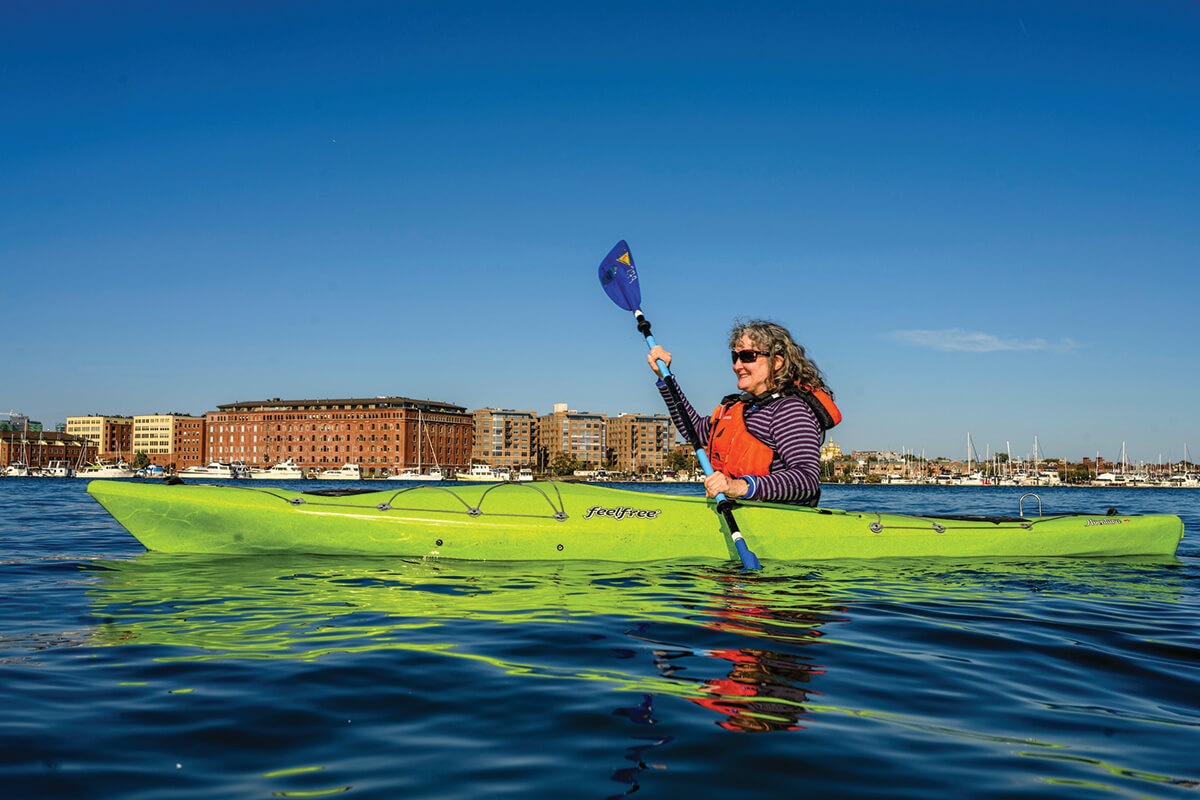
Delta is the most rural, but also one of the most longstanding of the Canton Kayak Club’s docks outside the city. In general, dock locations shift every so often, depending on the relationship of the owners of the various properties to the club, which leases the sites, mostly on a yearly basis. Until recently, the club maintained a dock at Nick’s Fish House, the popular Port Covington seafood restaurant, which has an adjacent marina where the club housed its boats. The lease wasn’t renewed at the end of the 2022 season, after Nick’s changed ownership. A rack location at Loch Raven Reservoir closed in 2020. But as one dock closes, another opens. In 2019, Scurr worked to open a dock at Chesapeake Harbour, an Annapolis gated community, and the next year another at Homeport Farm in an Anne Arundel County park; the most recent dock, at Downs Park in Pasadena, was established in 2021.
“That’s always been the challenge,” says Scurr of finding water access for the club’s kayaks. “Originally it was just two or three locations down at the Inner Harbor. And now it’s grown to provide amenities in Baltimore County and beyond. The goal is to offer a variety of locations for members to explore. Right now, the vast majority of our members are residents of Baltimore City. But it doesn’t have to be that way.” Scurr is actively looking to find dock locations in Cherry Hill. “They’re so close to the water,” he says. “It could make sense to have a rack in Middle Branch; it would be a wonderful amenity.” He’d also like to expand more beyond Baltimore.
“[Kayaking] breaks down the divide between city and county,” Scurr says. “It allows people to explore and to go to areas that they’ve never been to.”
Baltimore City Recreation and Parks has historically offered once-a-week summer kayaking from Middle Branch Park and the Science Center at the Inner Harbor. However, even though Baltimore is one of the oldest ports in this country, a city built by and for ship-builders, dockworkers, crabbers, and fishermen, many of its current residents don’t get out on the water.
“People should be able to do this activity and get on the water,” says Scurr, “and small crafts are the lowest-cost way to do that. It gives you a different perspective. It’s kind of like reclaiming our water.”
If Scurr sounds a bit like he’s proselytizing, that’s because he is. Get him talking, and he’ll stress not only the physical benefits of kayaking, but also its emotional and psychological benefits. “It’s an ideal vehicle to reach people; it can bring people together. There’s a low degree of stress, most times—as long as you pay attention to the weather.”
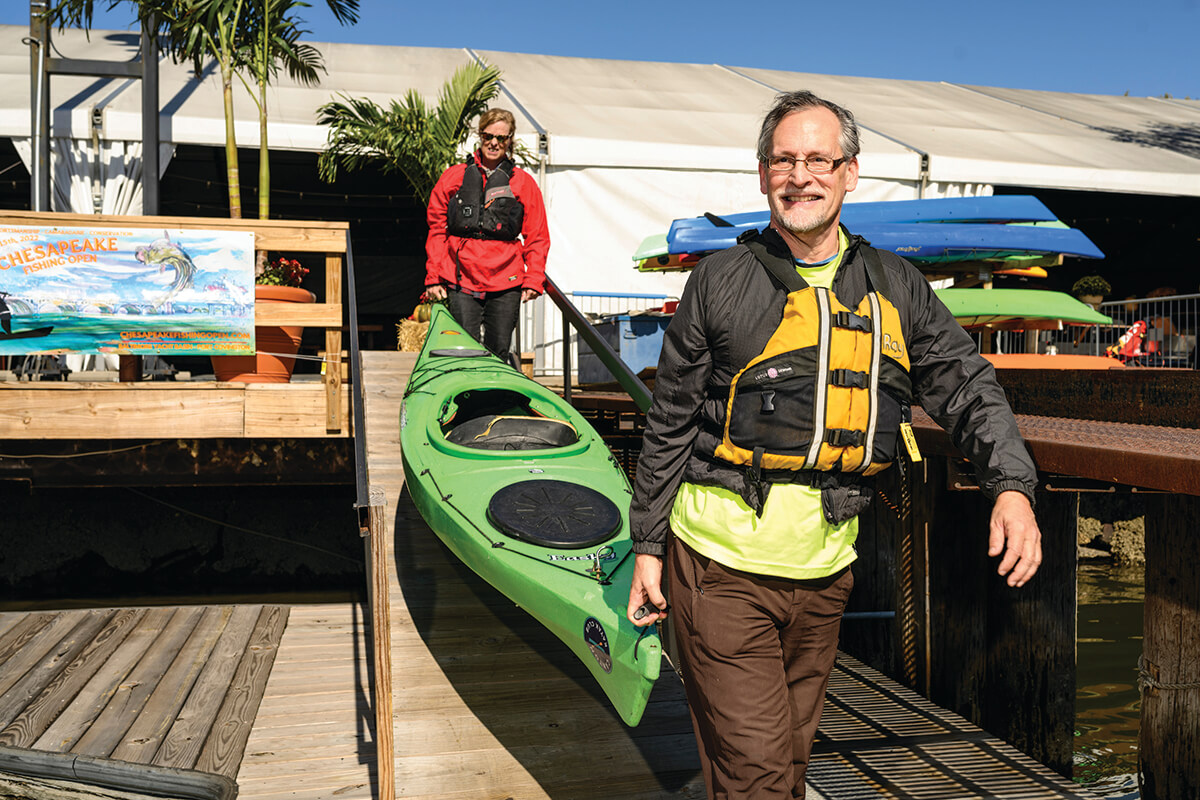
And unlike, say, sailing, kayaking is a gateway sport, without any particular prior knowledge or too much physical strength necessary. The club requires a three-hour orientation session, which goes over basic skills as well as safety. There’s also an additional life-saving class that members can take through the club to qualify them as club leaders.
Rob Bennett, the Federal Hill professor, likes the convenience of having the Locust Point dock so close to where he lives. “The ease of not having to get your own paddle, your own life jacket, your own boat,” he says of why he joined the club. “And it’s within a mile of the house.”
Bennett joined in 2022 and was soon kayaking three to four times a week, mostly early in the mornings before he went to work. Through Slack, he’d arrange for a few fellow kayakers to join him most days, enjoying the camaraderie and the chance to chat across the water as they paddled. In the off-season, he meets his fellow kayakers for coffee every few weeks. (The club also hosts occasional gatherings, often at Fells Point taverns, to keep in touch during the winter months.)
Bennett was out on the water on the November morning of what turned out to be the last day of the 2022 season—an afternoon storm was rolling in, bringing squalls and temperatures that would plunge the water down below 60 degrees. Scurr would later visit the docks and change the combinations on all the locks, thereby ensuring that everyone would be off the water until he reset them in the spring.
Out on the Inner Harbor shortly after dawn that last morning, Bennett had paddled around the marina, waving to the folks on the Water Taxi crossing the Inner Harbor.
“Good to see my yacht is still there,” he joked, nodding to someone’s fancy sailboat as he skirted the boats in the marina.
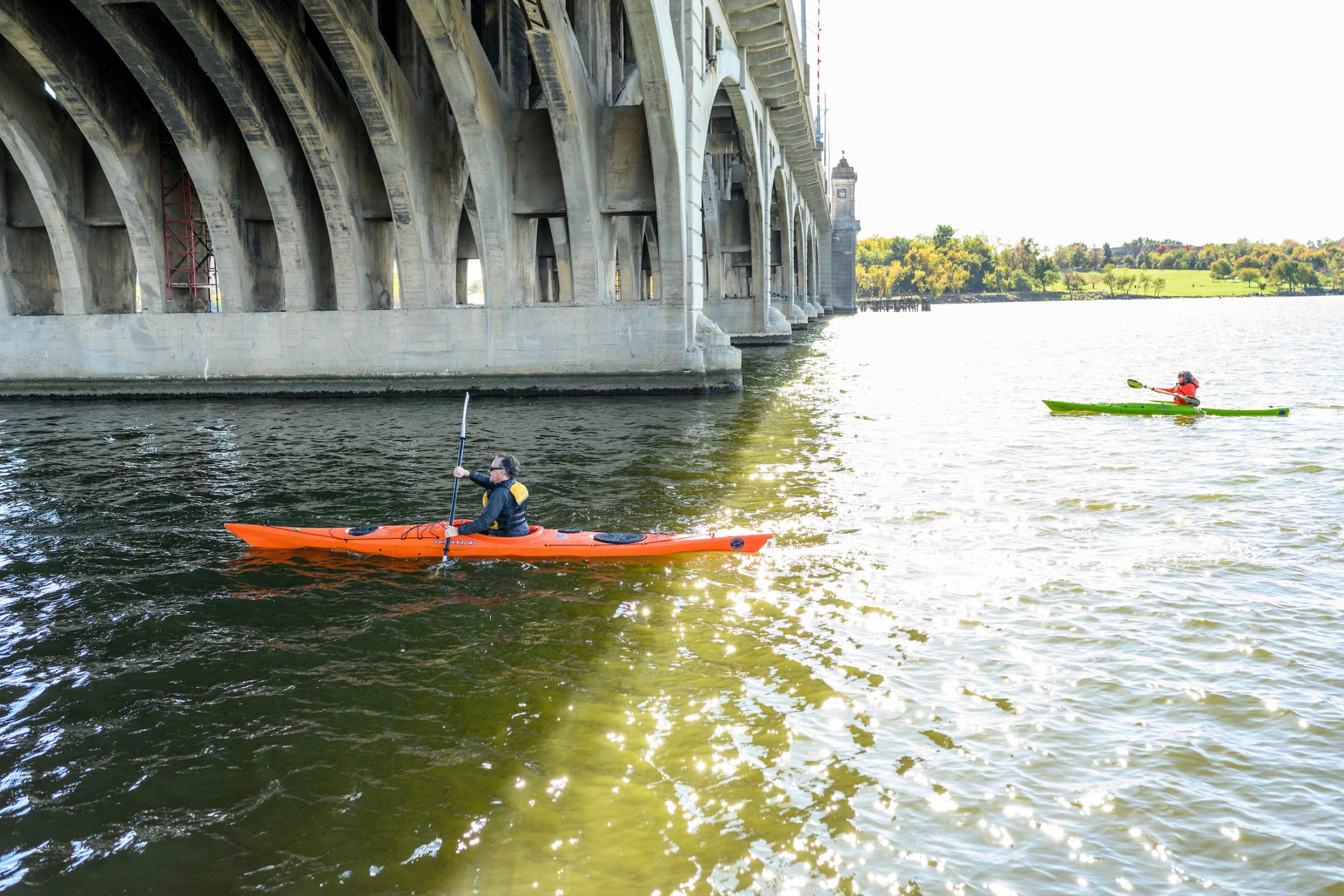
Seagulls moved around the sky as it grew lighter, some coming to rest on the racks of kayaks at the dilapidated Fells Point dock, one of the oldest of the club’s docks, which is finally slated to be replaced later this year. The paddles dipped in unison, the splashes alternating with the cries of the gulls. The kayaks turned into the sunrise, then made for the other side of the harbor, smoke from the Domino stacks merging into the skyline, the reds and blues and yellows of the boats like nautical flags above the waves.